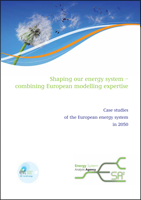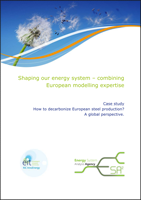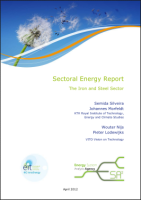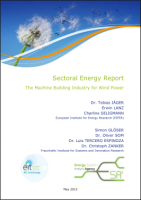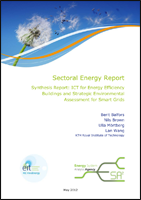Data Warehouse and Reports
Data Warehouse
Energy systems modelling is a data-intensive activity and the quality of results strongly depends on the availability of reliable data. With our comprehensive data warehouse service we provide a central and consistent database for the models and analyses. This harmonization is especially important with the use of multiple energy models. In addition, data is prepared in a consistent way, in other words there is an unambiguous determination of the origin and standardized use of the data.
Furthermore ESA² provides survey data and data from literature reviews as well as input and output data of model-based analyses to stakeholders from policy, industry and science.
Reports
ESA2 reports aims at providing detailed and highly sophisticated information on specific topics referring to the energy system as well as to energy-intensive industries. The following reports that were published in the framework of the KIC-InnoEnergy lighthouse innovation project “Energy System Analysis Agency” can be downloaded free of charge.
Download
Contents
Shaping Our Energy System – Combining European Modelling Expertise
The overarching aim of the case studies analysed in this report is to address the question of how the European energy system can be suitably transformed and how the ambitious climate goals in Europe and in the different member states can be achieved in an economically reasonable way. In other words the design of the future energy system in Europe is analysed against a background of a safe, sustainable and affordable energy supply for everyone, together with a strengthening of the European business location. For this purpose ESA2 applies its in-depth modelling expertise to provide scenario calculations complementing the EU Energy Roadmap 2050, published by the European Commission in December 2011. The overall methodological objective has been to demonstrate how model coupling and data harmonization can lead to superior results in terms of scope, consistency and transparency. For this purpose a selection and coupling of several models tailored to answer the research questions addressed has been undertaken.
Shaping Our Energy System – Combining European Modelling Expertise (Steel)
The scope of this study was to analyse future steel producing technologies and their costs within the context of global long-term steel use and global climate mitigation. Different technical expertise is united from different ESA2 partners, allowing the coupling of model-based analyses. Scenarios were created to investigate both the impact of future steel demand patterns, climate mitigation and a certain technology preference. In total, six scenarios were developed within two main groups with low and high estimates of steel demand evolution. The novelty of the approach is the technology detail for iron and steel production in a model traditionally used for energy technology cost optimization and the extension of the model to take restrictions on scrap availability into account as well as the saturation of the in-use stock of steel.
Sectoral Energy Report on the Iron and Steel Sector
The iron and steel sector has traditionally been considered an important industry for strategic reasons. The focus on high-quality and innovative products has granted the European iron and steel producers a prominent position on the global market for iron and steel products. Today, European industries are facing new challenges. In this Sectoral Energy Report, ESA2 aims to identify action areas for ensuring the competitiveness of European iron and steel producers in a context of stringent climate change mitigation requirements and increased global competition. Resources needed for steel production as well as the steel commodities themselves are traded on a global market. Hence, the sector in Europe is closely linked to trends in steel production in other regions. This report presents energy profiles for a number of regions which are key in steel production value chains, discussing regional trends in energy efficiency and GHG emissions reductions. The action areas identified require a system approach for reaching the set goals of climate change mitigation while remaining competitive.
Sectoral Energy Report – Machine-building for Wind Power
The report provides an overview of the wind power sector by firstly discussing current trends concerning technologies and market developments and their implications for the machine-building industry of the wind power sector, summarized as follows:
- Global wind turbine industry with average annual growth rates of more than 30 %.
- The structure of Original Equipment Manufacturers (OEMs) of the wind turbine industry range from smaller regional players to large international energy corporations.
- Declining number of OEMs is seen in the near future. Players in particular from China and India are expanding their global activities.
- A market segmentation based on regions and based on application: onshore (like U.S. and Spain) and offshore (like Germany) can be distinguished.
- Main technological developments in the future can be assumed in efficiency, reliability, performance and robustness and grid compatibility.
The second part of the report provides a selection of long-term energy sector related future scenarios for Germany, China, India and Denmark as examples with large growth rates in renewable energies, particularly for wind power.
- For Germany all research institutes estimate in their reference scenarios a decline for primary energy consumption (PEC), final energy consumption (FEC) as well as electricity power generation, while power capacities rise by 2050.
- PEC of oil and gas goes down over time in all studies.
- Consumption in the transport and private household sectors diminishes most.
- Shares of renewable energies of between 64 % and 80 % (2050) are seen for Germany. Wind power capacities vary between 23 GW and 107 GW (2050).
- In China wind power capacities are 40 to 60 times and in India between three and 16 times higher in the year 2050 compared to 2010, for Denmark capacities are predicted three times higher by the year 2030 compared to 2010.
Sectoral Energy Report on ICT for Energy Efficiency Buildings and Strategic Environmental Assessment for Smart Grids
Following is a synthesis of an investigation into how smart grids may be deployed to leverage improved end-use electric efficiency and environmental performance. The two complementary approaches are: How ICT solutions can be leveraged to increase energy efficiency (specifically for electricity) and improve environmental performance in the real estate sector in Sweden. This report shows that ICT for energy efficiency in buildings is primarily interesting in single family homes and in commercial property. Single family homes are important for the growth of this sector because of the large amount of electricity that is consumed in the sector (in particular for heating purposes) as well as the fact that the billing structure implies a significant incentive for home-owners to be interested in advanced solutions to decrease costs. In commercial property such solutions are interesting principally because such properties are already technically advanced, and there is an existing structure for energy management with specific interest in the kinds of technologies considered. The second part looks at the development of smart grids from the point of view of Strategic Environmental Assessment (SEA). The report concludes that there is currently little application of SEA in the energy sector due to the fact that many infrastructure decisions are made by private companies and not public authorities. A proposed solution to this is to apply SEA in the context of corporate sustainability initiatives. Further benefits from SEA for smart grids are its benefits in environmental enhancement and knowledge brokering.
